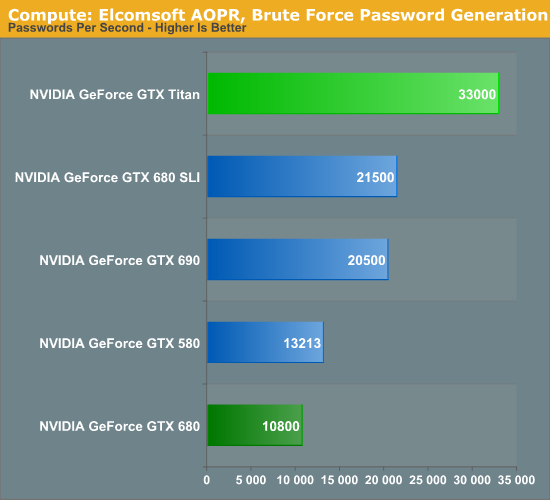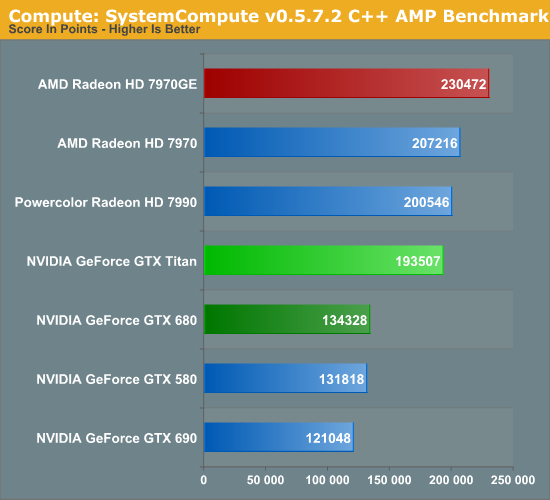NVIDIA’s GeForce GTX Titan Review, Part 2: Titan's Performance Unveiled
by Ryan Smith & Rahul Garg on February 21, 2013 9:00 AM ESTTitan’s Compute Performance, Cont
With Rahul having covered the basis of Titan’s strong compute performance, let’s shift gears a bit and take a look at real world usage.
On top of Rahul’s work with Titan, as part of our 2013 GPU benchmark suite we put together a larger number of compute benchmarks to try to cover real world usage, including the old standards of gaming usage (Civilization V) and ray tracing (LuxMark), along with several new tests. Unfortunately that got cut short when we discovered that OpenCL support is currently broken in the press drivers, which prevents us from using several of our tests. We still have our CUDA and DirectCompute benchmarks to look at, but a full look at Titan’s compute performance on our 2013 GPU benchmark suite will have to wait for another day.
For their part, NVIDIA of course already has OpenCL working on GK110 with Tesla. The issue is that somewhere between that and bringing up GK110 for Titan by integrating it into NVIDIA’s mainline GeForce drivers – specifically the new R314 branch – OpenCL support was broken. As a result we expect this will be fixed in short order, but it’s not something NVIDIA checked for ahead of the press launch of Titan, and it’s not something they could fix in time for today’s article.
Unfortunately this means that comparisons with Tahiti will be few and far between for now. Most significant cross-platform compute programs are OpenCL based rather than DirectCompute, so short of games and a couple other cases such as Ian’s C++ AMP benchmark, we don’t have too many cross-platform benchmarks to look at. With that out of the way, let’s dive into our condensed collection of compute benchmarks.
We’ll once more start with our DirectCompute game example, Civilization V, which uses DirectCompute to decompress textures on the fly. Civ V includes a sub-benchmark that exclusively tests the speed of their texture decompression algorithm by repeatedly decompressing the textures required for one of the game’s leader scenes. While DirectCompute is used in many games, this is one of the only games with a benchmark that can isolate the use of DirectCompute and its resulting performance.
Note that for 2013 we have changed the benchmark a bit, moving from using a single leader to using all of the leaders. As a result the reported numbers are higher, but they’re also not going to be comparable with this benchmark’s use from our 2012 datasets.

With Civilization V having launched in 2010, graphics cards have become significantly more powerful since then, far outpacing growth in the CPUs that feed them. As a result we’ve rather quickly drifted from being GPU bottlenecked to being CPU bottlenecked, as we see both in our Civ V game benchmarks and our DirectCompute benchmarks. For high-end GPUs the performance difference is rather minor; the gap between GTX 680 and Titan for example is 45fps, or just less than 10%. Still, it’s at least enough to get Titan past the 7970GE in this case.
Our second test is one of our new tests, utilizing Elcomsoft’s Advanced Office Password Recovery utility to take a look at GPU password generation. AOPR has separate CUDA and OpenCL kernels for NVIDIA and AMD cards respectively, which means it doesn’t follow the same code path on all GPUs but it is using an optimal path for each GPU it can handle. Unfortunately we’re having trouble getting it to recognize AMD 7900 series cards in this build, so we only have CUDA cards for the time being.

Password generation and other forms of brute force crypto is an area where the GTX 680 is particularly weak, thanks to the various compute aspects that have been stripped out in the name of efficiency. As a result it ends up below even the GTX 580 in these benchmarks, never mind AMD’s GCN cards. But with Titan/GK110 offering NVIDIA’s full compute performance, it rips through this task. In fact it more than doubles performance from both the GTX 680 and the GTX 580, indicating that the huge performance gains we’re seeing are coming from not just the additional function units, but from architectural optimizations and new instructions that improve overall efficiency and reduce the number of cycles needed to complete work on a password.
Altogether at 33K passwords/second Titan is not just faster than GTX 680, but it’s faster than GTX 690 and GTX 680 SLI, making this a test where one big GPU (and its full compute performance) is better than two smaller GPUs. It will be interesting to see where the 7970 GHz Edition and other Tahiti cards place in this test once we can get them up and running.
Our final test in our abbreviated compute benchmark suite is our very own Dr. Ian Cutress’s SystemCompute benchmark, which is a collection of several different fundamental compute algorithms. Rahul went into greater detail on this back in his look at Titan’s compute performance, but I wanted to go over it again quickly with the full lineup of cards we’ve tested.

Surprisingly, for all of its performance gains relative to GTX 680, Titan still falls notably behind the 7970GE here. Given Titan’s theoretical performance and the fundamental nature of this test we would have expected it to do better. But without additional cross-platform tests it’s hard to say whether this is something where AMD’s GCN architecture continues to shine over Kepler, or if perhaps it’s a weakness in NVIDIA’s current DirectCompute implementation for GK110. Time will tell on this one, but in the meantime this is the first solid sign that Tahiti may be more of a match for GK110 than it’s typically given credit for.










337 Comments
View All Comments
chizow - Friday, February 22, 2013 - link
Sorry Ryan but that's a bit of a cop-out exuse imo. Anyone who can fork out $1K for a few GPUs in SLI should be able to figure out how to google SLI bits and enter them into Nvidia Inspector. They are "enthusiasts" afterall, right?SLI working on launch day with proper SLI bits:
http://www.overclock.net/t/1334390/how-to-get-prop...
Nvidia is usually pretty good about updating these bits or launching optimized drivers ahead of a big game launch, but sometimes they are a few days behind. The same can be said for single-GPU performance optimizations, but obviously less frequently than SLI.
With few exceptions over the course of my 5 year run with SLI, I've been able to get SLI working on Day 1 for most major game launches. AA is more hit or miss, but generally with Nvidia you don't have to wait for updates if you know how to manipulate SLI/AA bits (or use google).
In any case, I think Titan has created a new paradigm that may need to be addressed, where 2 performance parts are going to be preferable over a single GPU, when those 2 parts in CF/SLI offer 150% of the performance at 75% of the price.
Veteranv2 - Thursday, February 21, 2013 - link
And that is a subjective view. Not objective.You don't have 1 graph where you prove dual GPU's are inconsistent. You don't prove your point, you just bring up a subjective view defending a 1000$ card which is crap compared to best offer from AMD...
ronin22 - Thursday, February 21, 2013 - link
Haters gonna hate.CeriseCogburn - Thursday, February 21, 2013 - link
liars gonna liehttp://www.pcper.com/reviews/Graphics-Cards/NVIDIA...
CeriseCogburn - Thursday, February 21, 2013 - link
here's a chart showing how amd fails utterly...http://www.pcper.com/reviews/Graphics-Cards/NVIDIA...
Have fun amd fanboy, the lies you live by are now exposed.
Veteranv2 - Friday, February 22, 2013 - link
Same comment for you:Wow, you base your opinion on 1 game on a point that 1 review site has made without knowing that the FRAPS software measures correctly and that drivers are good with that game?
Wow, that blows my mind. How dumb can be people be?
This is the same like saying, wow this 1 musquito didn't give me malaria, malaria doesn't exist....
I am not a fanboy, except for my wallet and honesty.
Anandtech makes a point which it does not prove. That is my point. Hence if you cannot prove a point, but still make it, that makes you subjective. So either prove it, or shut up about it and be objective.
veppers - Saturday, February 23, 2013 - link
I'm not sure you should be calling anyone out for being a fanboy when your childish pro-Nvidia posts are here for all to see. (happy Nvidia customer here just incase you wanted to go there)Also, how many times are you going to spam that same link?
CeriseCogburn - Saturday, February 23, 2013 - link
As many times as the lying whiners pull their stupid crap.It should be spammed about 300 times in all the articles here since the Jan 2012 release of the amd failship 79xx, shouldn't it ?
Hello amd fanboy.
CeriseCogburn - Tuesday, February 26, 2013 - link
" SLI profiles for optimum scaling, NVIDIA has done a very good job here in the past, and out of the 19 games in our test suite, SLI only fails in F1 2012. Compare that to 6 out of 19 failed titles with AMD CrossFire. "http://www.techpowerup.com/reviews/NVIDIA/GeForce_...
LOL - yes you sure know what you're talking about...
CeriseCogburn - Thursday, February 21, 2013 - link
Take a look at HOW CRAP amd dual top end card setups actually are and how FRAPS, which this site regularly uses has been SCREWING nVidia for years...http://www.pcper.com/reviews/Graphics-Cards/NVIDIA...
Enjoy the years of lies you have swallowed whole, while sentient human beings like myself have warned against.